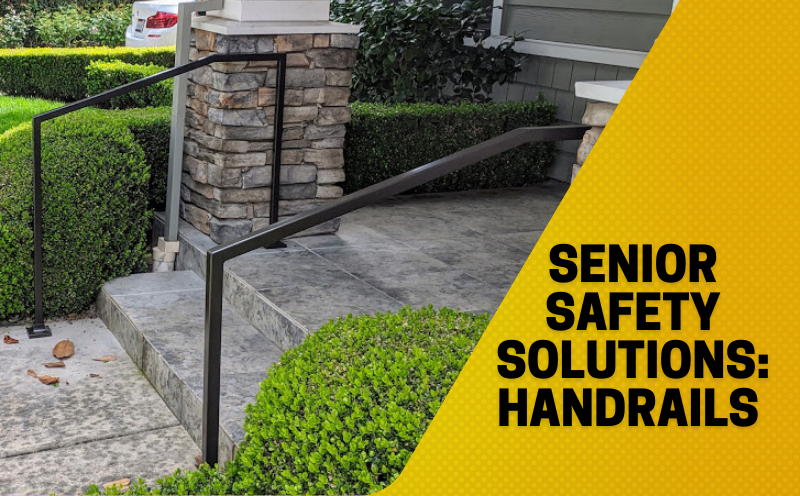
Senior safety solutions and home modifications are increasingly recognized as a necessity.
As you start to look into senior safety systems, one of the first things you’ll quickly find out is how important it is to invest in handrails and transfer poles. But what good are they?
Handrails and transfer poles are fundamental safety features intended to help prevent falls for seniors and people with disabilities. They serve both structural and aesthetic purposes. Most designs feature tubular supports, but decorative styles can also be found.
In this article, we will dive into the benefits, features, and installation of handrails. In the following article, we will see how the different types of transfer poles can benefit seniors in navigating through their daily activities.
Handrails/ Stair Railings
How Can Handrails Benefit Seniors?
When someone is about to fall, the first reaction is to look down. The second thing is to try and grab something. That’s why handrails are so important – they improve safety by ensuring that someone can securely grip them while they’re still moving up and down the stairs. The only way to ensure handrails are safe and sturdy is to have them professionally installed.
Handrails are simple and effective ways to prevent fall accidents at home. They help seniors and those with mobility issues to stay in place and maintain stability.
Elderly people can use handrails as leverage to pull themselves up when they need to go upstairs.
Handrails can also be helpful for caregivers and other family members who want to assist an elderly or disabled person to navigate around the house.
Types of Handrails
Stairs are tricky to navigate and even trickier to design. There are many different types of stairs and handrails, and your choice of style—as well as the number of people using your staircase—will determine which type is best for you.
Handrails come in two types:
- Integrated handrails run along the top of the spindles, and are a part of the balustrade, so it’s all one piece.
- Wall-mounted handrails are separate elements to the balustrade.
Where To Install Handrails
The best place for handrails is where people are most likely to fall. That’s why staircases are a hot spot — it’s hard to see them from ground level, so when you step up onto them, you have no idea if there’s a step or rail under your foot until it’s too late.
Handrails can be used in garages, basements, hallways, and bathrooms.
They also come in handy for seniors living in mobile homes, apartments, or condominiums since they can be installed on balconies or other places where there is no railing or access to an exterior handrail.
Challenges
“Can’t I just drag some rails in here and call it a day?” – said nobody, ever.
Installing handrails isn’t as easy as it sounds. It is more than just screwing in a few posts. It isn’t something you can just rush through either. You need to get the job done right or face the consequences.
Handrails for stairs need to be designed to meet building code, but the process may still be challenging because of the impact the design can have on the overall aesthetic of a property.
They are also a bit expensive to install. This can present a challenge especially if the budget is limited. Some people are tempted to go for a cheaper option with poor quality, hence exposing themselves to future risks.
Things to Remember
There are several styles and materials to choose from with regard to aesthetics, functionality, and cost. While there is no single, best solution for every application, there are commonalities among handrails that can help you make a well-informed decision.
When you’re shopping for a railing, start by looking at the design of the product that you’re installing. If you want to keep it simple and uncomplicated, opting for a decorative wrought iron handrail or a cost-effective tube style is your best bet.
If you want something more sophisticated — say, an ornate design with intricate details — you’ll need to consider the materials used in its construction.
Today’s handrails can be made from steel or aluminum tubing. Steel has historically been the go-to material for handrails, but aluminum can be even more attractive when considering that it offers greater strength and corrosion resistance.
- Aluminum tubing offers great flexibility with regards to installation options
- Wooden handrails tend to have lower weight capacities and are usually built on-site using wooden rails with decorative metal caps
- Steel handrails are a little heavier but offer improved resistance against twisting and bending during use
- Plastic handrails weigh less than steel but provide similar strength and durability
Conclusion
Handrails are important aspects of aging in place.
In practical terms, they’re used to prevent falls and injuries.
In theory, they serve the greater good by improving your quality of life.
A lack of these amenities can make life difficult for seniors. This is especially true if the key to independent living is mobility, as many elderly people require.
Recent Comments